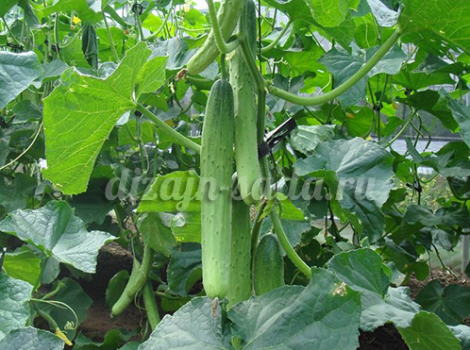Content
- 1 Saintpaulia, who are you?
- 2 What flower is called a chimera?
- 3 Meaning of the word
- 4 How chimeras appear
- 5 First difficulties
- 6 Chimera types
- 7 Chimera varieties
- 8 How to propagate a chimera
- 9 Correct care
- 10 Indoor violet - description
- 11 Types and varieties of violets with photos, names, descriptions
- 12 see also
- 13 Frosty Cherry
- 14 Ice rose
- 15 Chic poppy
- 16 Isadora
- 17 Lituanica
- 18 Rosemary
- 19 The bride's bouquet
- 20 Amadeus
- 21 Magenta
- 22 Birth of love
- 23 Gray ocean
- 24 Chimera
- 25 Paul Bunyan
- 26 Darling
- 27 The land of crimson clouds
- 28 Conclusion
Lovers of home flowers appreciate the violet for its touching beauty and tenderness. But among the huge variety of flowers, Saintpaulia, or the Usambara violet, is especially distinguished, a unique subspecies of which is the chimera violet. What kind of miracle is this and why do flower growers all over the world collect this plant?
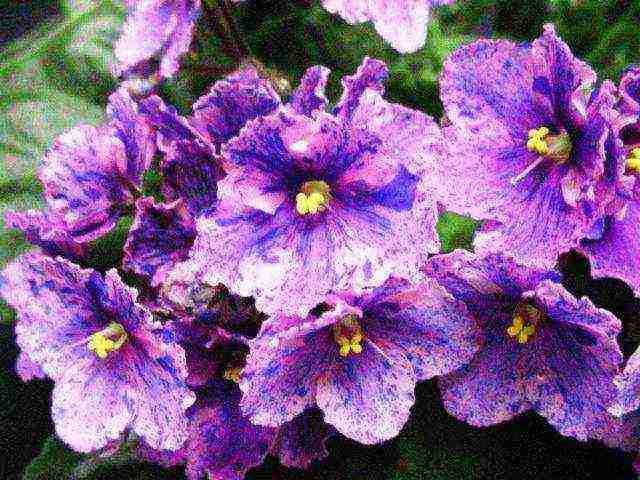
Saintpaulia, who are you?
Saintpaulia is a representative of the tropical Gesneriaceae family. It belongs to the flowering genus and is considered one of the most common indoor flowers. Although one of the names of this species is the uzambar violet, the flower has nothing to do with ordinary indoor violets. These are completely different plants. Violet, or pansies, is a member of the violet family and is a garden flower, not a tropical flower.
What flower is called a chimera?
Not every Saintpaulia is a chimera. This is the name of a plant in which cells of Saintpaulias of different varieties are intertwined, merged together. Unique is that the cells of primary plants do not mix with each other. Each petal consists of two genetic layers that differ in color. The main layer of cells gives the background color of the petals, and the additional layer creates a clear stripe or spot. If you make a cross-section of the petal, then the background (main) and additional cells are clearly distinguishable.
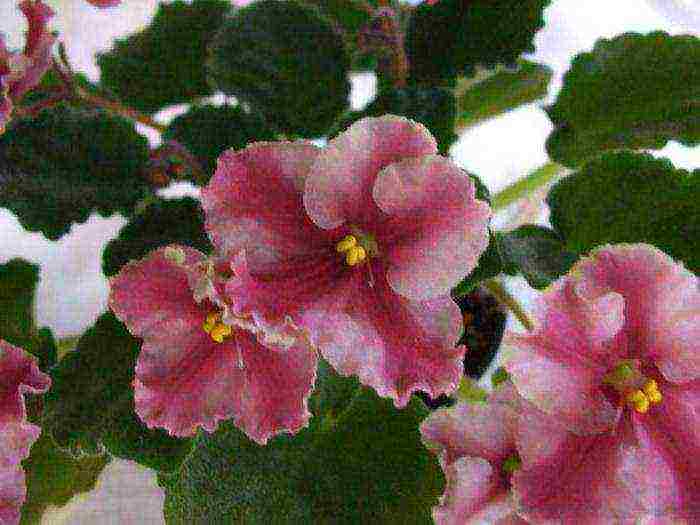
Meaning of the word
Why some species of Saintpaulias are called "chimera violet" is now clear. And what exactly does this name mean?
The word "chimera" comes from Greek mythology. This was the name of the mythological monster, which has the head of a lion, the body of a goat and a dragon's tail. If biologists told about this creature, they would emphasize that the organism consists of three groups of cellular tissue with different genetic characteristics. Agree that it is quite difficult to believe in the existence of such an organism, this became the reason for the appearance of a second meaning in the word. So they began to call bizarre fantasies that are difficult to believe. Violet chimera is the most bizarre fantasy created by man from natural material. Probably, for this she is appreciated.
How chimeras appear
No matter how hard the scientists try, they have not yet succeeded in removing the chimera in the laboratory. This is the first time a flower like this is the result of a partial mutation.It happened something like this: a large group of cells inherited maternal traits, and a smaller part of the cells inherited traits of a different species. This mutation happened more than a hundred years ago, just at the time when Saintpaulia was domesticated and became popular in home floriculture.
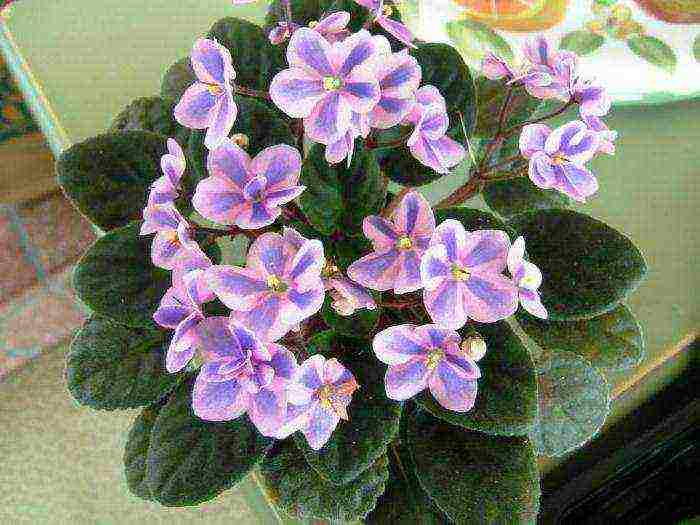
Chimeric mutations were initially completely random. The fact is that different types of tissues simply adjoined each other, and did not mix, so the mutation was unstable and rarely reproduced during reproduction. So a pink violet chimera with a purple stripe, when multiplied, gave monochromatic plants.
First difficulties
The official communities did not immediately agree that chimeras can be considered a separate variety of Saintpaulias. The American community of flower growers - lovers of violets, motivated their refusal by the fact that it is impossible to achieve a repetition of the color of plants during cuttings propagation. It took a long time to prove that the violet (Saintpaulia) gives flowering and leafy chimeras with other methods of reproduction.
Today it has been proven that the instability of reproduction can be overcome, and there are no problems with the registration of new varieties. However, the methods of obtaining such plants are very laborious, which could not but affect the price of chimeras. So, in America, a baby violet chimera costs from 5 to 30 dollars.
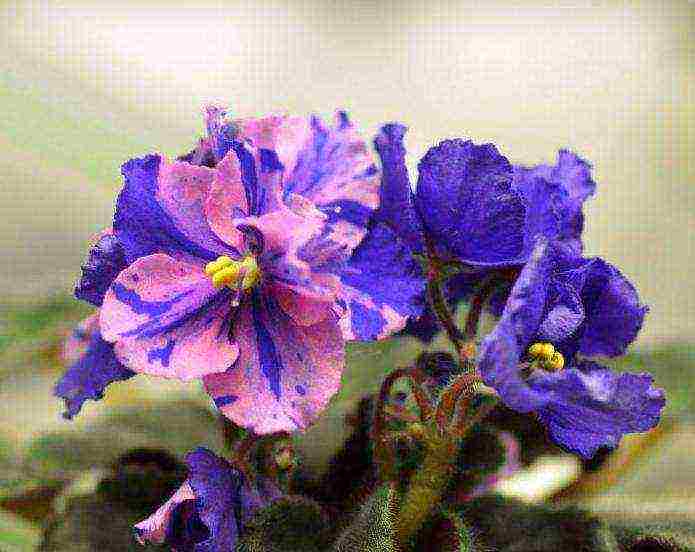
Chimera types
Despite the fact that the color range of chimeras is very diverse, plants are divided into only 2 types of color:
- Straight. In this case, the petals are lighter in color than the central stripe.
- Back. In such a chimera, the central stripe is lighter than the base of the petal.
But even with such a division, there are plants that do not fall under any of the types. These can be leafy chimeras. Violet Saintpaulia simply amazes with its originality. For example, a leaf chimera has a monochromatic flower, but the leaves have unique patterns, which is also very beautiful.
Chimera varieties
There are quite a few varieties of the uzambar violet. There are more than a hundred of them in the official list. Some varieties are considered expensive collectible, some are industrial. Industrial varieties often have less decorative value, but have long, abundant flowering.

In general, chimera violets, whose varieties are sometimes difficult to classify, have the following varieties:
- standard;
- mini;
- half-mini;
- suspended (ampel or trailer);
- leafy.
New varieties are obtained through painstaking work, but sometimes genetic failures occur, and the common Saintpaulia produces chimeric flowers. The flower grower becomes the owner of a unique chimera that exists in a single copy.
How to propagate a chimera
Common violet is easily propagated by cutting leaves. With chimeras, as you already understood, this number does not work. Chimera violets are much more difficult to propagate. To repeat the fantasy color, 3 types of offspring have been developed:
- Rooting of peduncles. In this case, the feature of the Saintpaulia peduncle is used, on which there is a bract with a dormant bud. With the rooting of the peduncle, the bud comes out of a state of rest and develops into a baby. Thus, the chimeric qualities of the flower are preserved.
- Rooting of the detached top of the plant. The upper part of the flower is cut without damaging the growth point and planted in a flowerpot with a light substrate. Within a month, the top is kept in greenhouse conditions to form the roots.
- Violation of the point of growth of the plant. After removing the top, the plant remains without a growth point, which leads to the formation of stepchildren with new apex points. The stepchildren can be separated and rooted, keeping the fantasy colors of the primary plant.
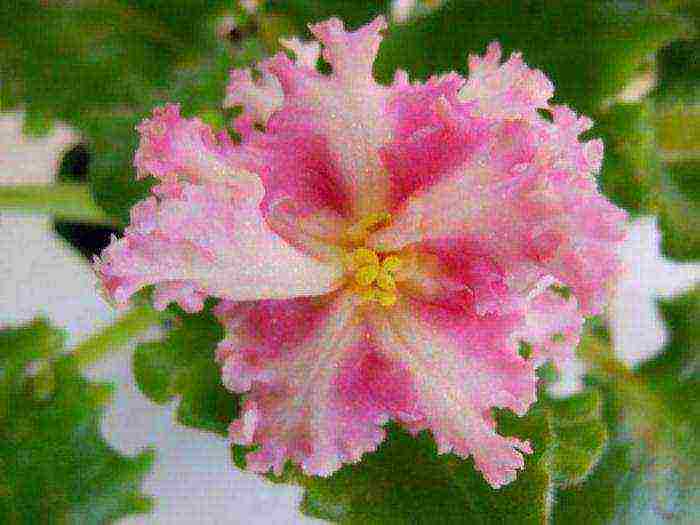
Sometimes flower growers are lucky, and stepchildren form on the plant themselves. Violet chimera, the reproduction of which does not require additional effort, is a great success.
Correct care
In order for a blooming beauty to feel good in a new home, she needs to be provided with decent care. To do this, you need to remember the basic rules:
- Violet chimera prefers windows on the east or west side.
- The location should be well lit, but not in direct sunlight.
- The most favorable room temperature is + 22-24 ° С. Interestingly, when growing chimeras, it is necessary to maintain the same temperature both day and night. If it fluctuates, then the flowers will receive a low-saturated color gamut and will differ from each other.
- When the temperature is too high, the content of Saintpaulia can darken and lose its fantasy color. The flower will become monochromatic, but under favorable conditions, the next flowering will again be chimeric.
- Watering Saintpaulia is necessary with settled water at room temperature. Watering can be done both in the pallet and from above. Excess moisture is drained after 10-15 minutes. The frequency of watering the plant depends on the temperature and humidity of the room. This is usually 1-2 times a week.
- Chimeras do not need frequent feeding. But if the flower is depleted, then you can use liquid or granular fertilizer for Saintpaulia. You cannot overfeed the plant. It is optimal to apply top dressing once a month.
Following the above recommendations, you can grow a beautiful, extraordinary plant that will become the pride of a florist.
Indoor violet (Latin Saintpaulia) came from the genus Saintpaulia, the Gesneriev family. This plant was identified as a separate genus by the scientist Hermann Wendland. which gave her the name Saintpaulia. It resembles a real violet (Viola), and therefore the plant is called the Usambara or African violet by the place of origin of the flower.
Indoor violet - description
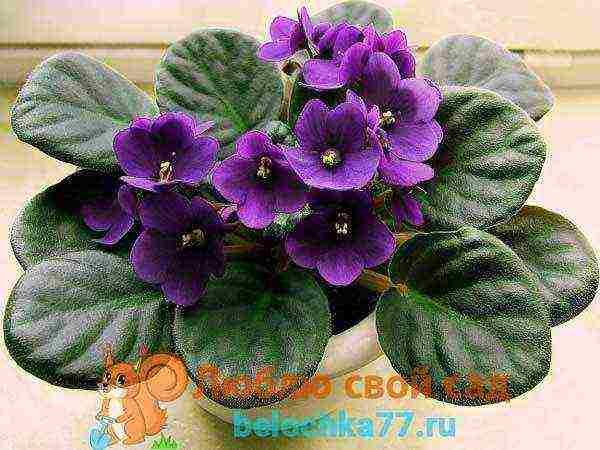
Indoor violet belongs to perennial herbaceous plants. She has an underdeveloped fibrous root system and fleshy stems. Depending on the species, the stems can be short, with leaves growing at the roots and forming a rosette, or elongated, branching with a large number of hanging rosettes. The stem diameter can be from 6 to 60 centimeters long.
The leaves are round, elongated or ovoid. The base is heart-shaped or simple. The tip is rounded or sharp. The edges are light, slightly rounded or coarsely serrated. The leaves are flat, strongly corrugated, slightly wavy or curved to one side or the other.
The leaves are green in color, sometimes with silvery or golden hues. Sometimes there are cream, olive, lettuce, yellow or pink patches on the leaves. Multi-colored areas are located at the edges of the sheet, at the base, or form a variety of patterns. The inner side of the leaf is most often silvery-green, sometimes it has a red tint.
Types and varieties of violets with photos, names, descriptions
Violet has become the ancestor of many varieties. Their distinctive feature is the shape and shades of colors. Semi-double and double varieties were bred. The colors are mixed. Now you can see violets with spots, stains, contrasting edges, patterns, stripes and splashes.
Semi-double violet
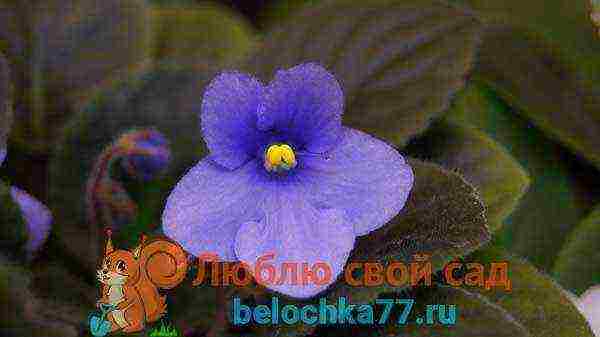 Semi-double violet
Semi-double violet
The petals are covered with very small shiny balls. Sometimes there are species covered with soft fluff. Such violets are called velvet. The edge of the petal is strongly corrugated or slightly wavy.
Terry violet
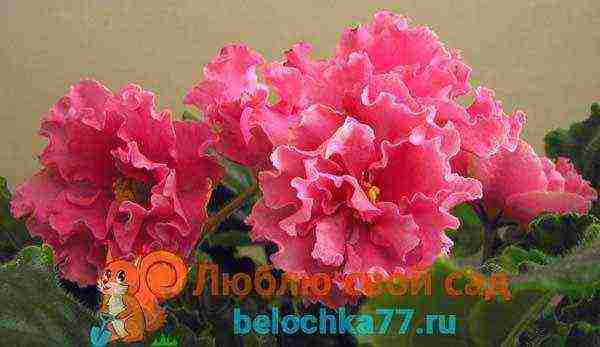
Flowers form voluminous cluster-like inflorescences. The diameter of the flowers ranges from 2.5 to 9 centimeters. The color of the petals can be white, blue, purple, purple and other shades.
Indoor violet varieties are divided into 3 groups:
- variegated;
- collectible;
- industrial.
Variegated violets have a bright color of the leaves. They are painted in various colors. Border often stands out well. Breeders have bred species that have large double flowers of different colors.
Collectible violets characterized by voluminous inflorescences up to 7 centimeters in size. They have large double wavy petals. The color is different, from snow-white to deep blue shades. Leaves with wavy edges have different colors.
Industrial violets intended for mass cultivation. They are not demanding to care for.
Depending on the location of the petals, the size of the flower, violets are divided into 5 types:
- star;
- pansies;
- bowl;
- bell;
- wasp.
Violet Star
Violets of this species have the same petal size. They are evenly spaced around the core.
The beauty queen
 Variety Goddess of Beauty
Variety Goddess of Beauty
The inflorescences form double bright pink stars with a purple-violet tint. Large basal bush. Leaves are dark green in color.
Marshmallow
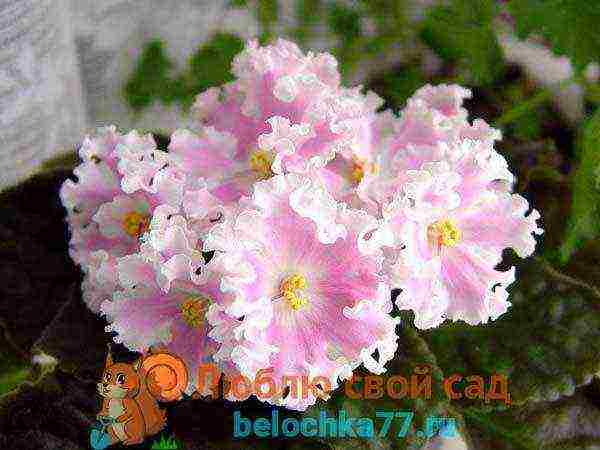 Zephyr variety
Zephyr variety
Large, creamy white, semi-double or double buds with coral or pink strokes on the surface. The edges are wavy. Peduncles are large, erect. The leaves are light green. The outlet is large, but compact. The plant grows quickly. At elevated temperatures, it can bloom with simple white flowers. When watering, water should not fall on the leaves.
Pauline Viardot
 Pauline Viardot variety
Pauline Viardot variety
The flowers are large, simple or semi-double, painted in a wine shade. The edge is bordered with a thin white ruffle. Flowers are arranged vertically. The variegated rosette is compact, bright.
Black Pearl
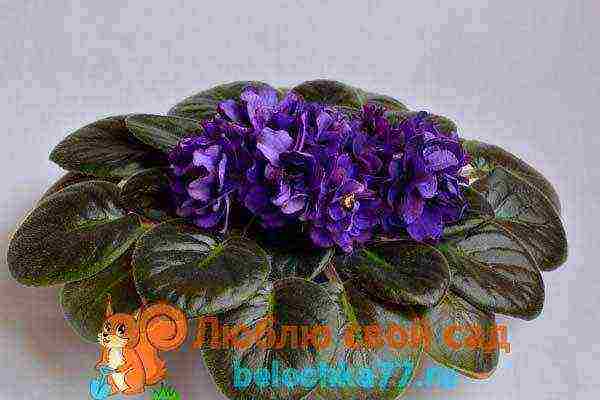 Variety Black Pearl
Variety Black Pearl
Flowers are large, densely double. The velvet color surprises with the overflow of purple and violet tones. The socket is standard. The leaves are oval, dark green. Petioles are long, strong.
Bullfight
 Variety Bullfight
Variety Bullfight
The flowers are very large, with a diameter equal to 8 centimeters. The shape of the flowers is semi-double or double. The color is thick burgundy. Leaves are light green, pointed at the ends.
Beautiful creole
 Variety Lovely Creole
Variety Lovely Creole
It is a prolific and undemanding resistant variety with velvety flowers. Violet blooms often and for a long time. The compact small outlet contains a variety of simple dark blue, velvety colors. The buds are large, 5 centimeters in diameter. The edges have a white border that sometimes turns light green. The stem is burgundy, strong.
Cinderella's Dream
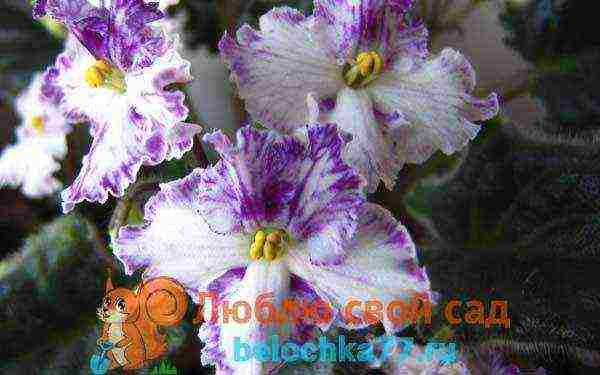 Variety Cinderella's Dream
Variety Cinderella's Dream
The flowers are semi-double, large, lacy, light purple with a raspberry tint. The petals are covered with a purple-violet pattern. The upper petals are darker, small in size. Fringed edges, greenish. The border is corrugated, purple along the edge of the petal. The socket is flat. The leaves are wavy, dark, evenly colored.
Viscount
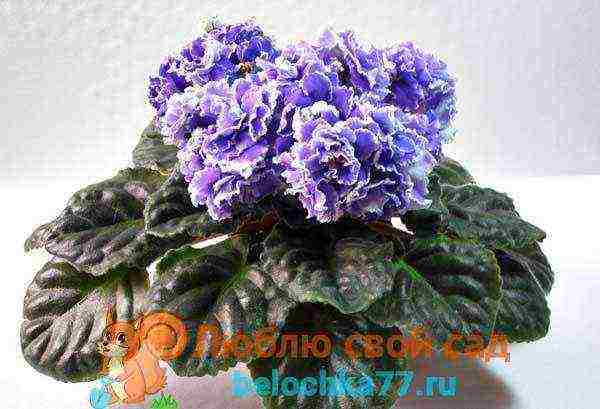 Variety Viscount
Variety Viscount
The flowers are blue, wavy, large, double or semi-double. Edges with corrugated wide white border. Quilted leaves, dark green. The socket is simple.
Magenta
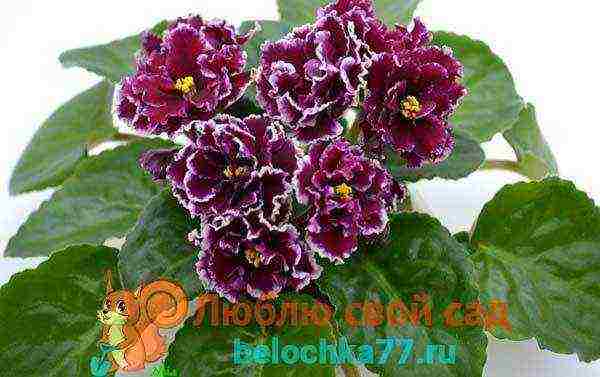 Magenta variety
Magenta variety
Flowers are semi-double or double, rather large. The color is saturated, red-burgundy. The edges have a discontinuous white wavy border. The socket is small. The leaves are pointed at the ends, light green in color.
Black Prince
 Variety Black Prince
Variety Black Prince
Large black-red double flowers. The foliage is dark green. The wrong side is red. The size of the bush is standard.
Blue fog
 Variety Blue Mist
Variety Blue Mist
This is a standard variety with double, rather large, blue buds. The edges of the buds are decorated with a white border. The stem is shortened. Medium leaf rosette. Leaves are long-petiolate, dark green in color, rounded. The edges are wavy.
Winter smiles
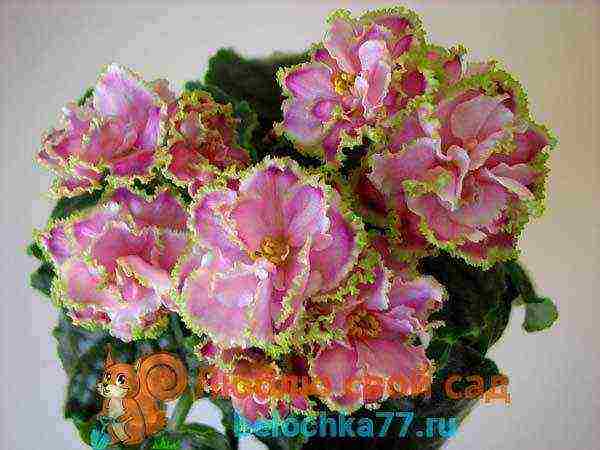 Variety Winter smiles
Variety Winter smiles
The variety is unpretentious, semi-double, lush and abundantly blooming. The flowers are pink. The edges are crimson with light green or yellowish green fringes. The petals reach 6 centimeters. Fringe turns white at high temperatures. It becomes more noticeable when the plant is grown in a cool room. Green leaves with olive tint, slightly elongated, embossed, quilted. The rosette is flat, medium-sized, growing up to 35-40 centimeters.
Violet Pansies
This species has a 5-petal bud. The size of the upper two is smaller than that of the lower three petals.
Spring outbreak
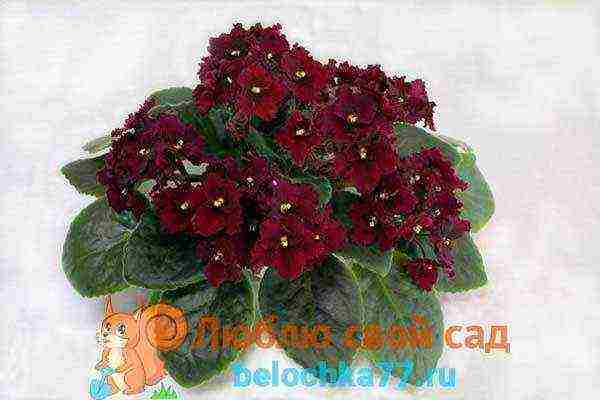 Variety Spring Flash
Variety Spring Flash
Early variety, blooms for a long time. The flowers are velvety.The petals inside the flower are bright yellow, the outer ones are burgundy-brown. Some flowers are completely burgundy or yellow. The variety is suitable for ampel cultivation.
Heavenly Queen
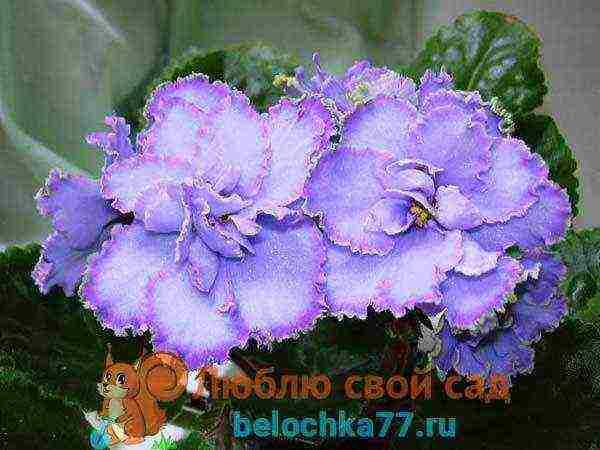 Variety Heavenly Queen
Variety Heavenly Queen
The bright blue flowers turn lilac over time. The edge of the petal is pink.
Violet Bowl
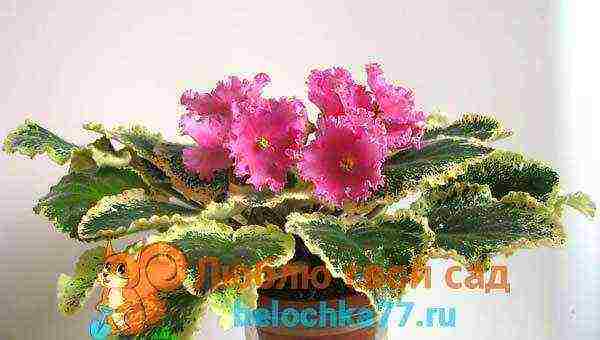 Variety Bowl
Variety Bowl
These violets have petals that have not grown together at the base. The bud does not fully open, retaining its shape throughout the entire flowering.
Violet Boo Man
 Boo Man variety
Boo Man variety
Flowers can be double or semi-double. The color is sky blue. The upper petals are white. The diameter is small, reaching 3 centimeters. Leaves are oval, deep green.
Ming dynasty
 Variety Ming Dynasty
Variety Ming Dynasty
The variety is distinguished by a bowl-shaped shape. The petals are white. The edges are slightly corrugated, pale pink in color. Leaves are bright green, variegated, wavy edges.
Violet Bell
The bell violet has petals fused at the base. The flower is like a bell, it cannot fully open.
Shining bell
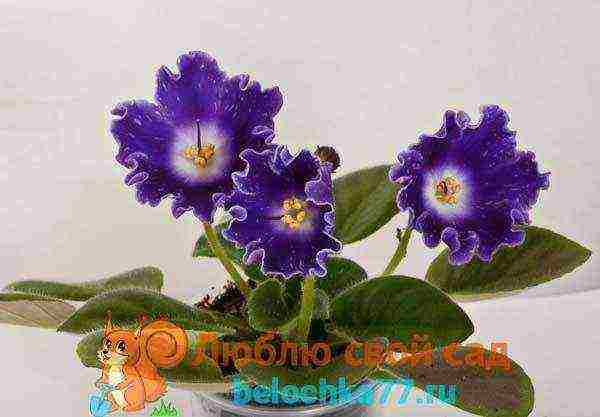 Variety Shining Bell
Variety Shining Bell
The variety develops flowers in the form of blue bells. The edges are wavy. They show rare touches of fantasy. The eye is bright yellow. Leaves are green in color. The rosette is of the correct shape.
Sea wolf
 Variety Sea wolf
Variety Sea wolf
This is a semi-double variety. The flowers are blue, large, up to 8 centimeters in diameter. The edges are wavy. The petals are wavy, with a mesh pattern, which is clearly visible after the bud is completely dissolved. The leaves are drooping, dark green, fleshy, large.
Chanson
 Chanson variety
Chanson variety
It is an unpretentious, abundantly and long-blooming terry variety with bell-like flowers. The flower consists of a huge number of purple-purple or dark blue velvety petals, playing in the light in different shades. Wavy petals slightly shade light or dark pink spots. The leaves are shiny, smooth, dark green. The rosette is symmetrical, large.
Violet Wasp
In this violet species, the petals are completely separated. Two are rolled up into a tube, and three elongated hang down.
Saintpaulia Blue Teil Fly
 Blue Teill Fly variety
Blue Teill Fly variety
The flowers are bright blue. The upper petals are tubular, the lower ones are elongated. The leaves are fleecy, rolled into small bags.
Zemfira
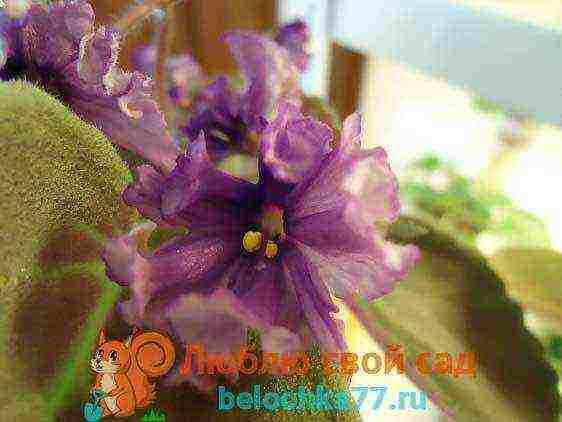 Zemfira variety
Zemfira variety
Tubular flowers are simple or semi-double, lilac in color. Corrugated edges. Medium socket. Leaves are green, variegated in the center.
Varieties of violets that cannot be classified are divided into types: Chimeras, Mini, Retro, Variegated, Ampelny, white, pink, purple.
Chimeras
This violet is a subspecies. She combined several varieties of Saintpaulias. The petals of this violet have 2 genetic layers with different colors. The background is colored by the main cells, and the top layer of cells is depicted as a spot, a clear stripe. The plant combines 3 types of flowers with different genetic characteristics. Violet is endowed with a wide range of colors. Its coloration is divided into 2 main types:
- straight;
- back.
In the first case, the petals are lighter than the strip in the center. In the second case, the base is darker than the strip or spot in the center.
There are also chimeras that do not fit the description of these types, these are leafy violets. Their flower can be one-color, and the foliage is painted with intricate patterns.
Dance of the Galaxies
 Variety Dance of the Galaxies
Variety Dance of the Galaxies
Flowers-stars are large, bright purple. The edges of the petals are darkened, have a thin white border. The petals are decorated with frequent white fantasy polka dots. Quilted leaves, dark green. The seamy side is red. The socket is standard.
Firebird
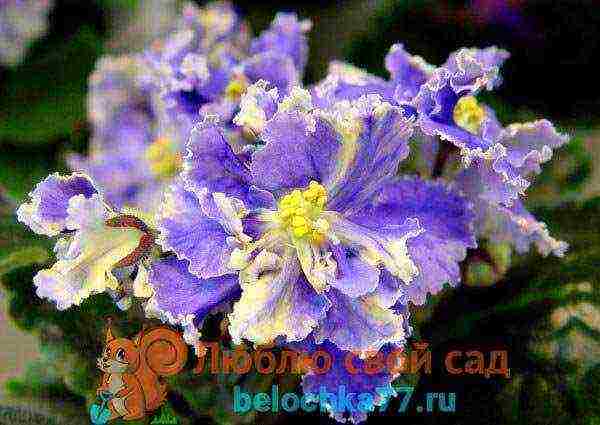 Firebird variety
Firebird variety
Semi-double light blue corollas have bright large yellow strokes. The petals are corrugated, uneven. The rosette consists of wavy green leaves.
Yesenia
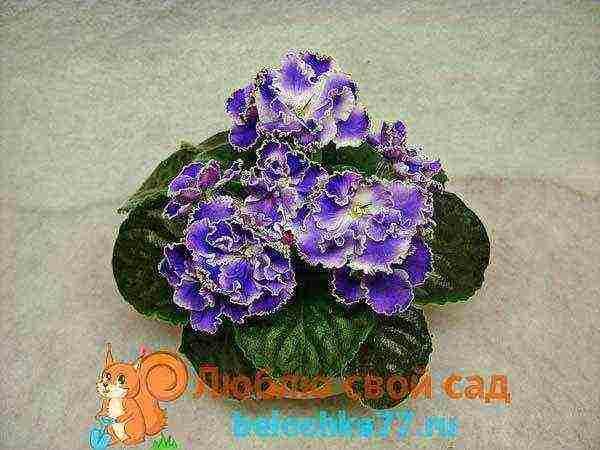 Yesenia variety
Yesenia variety
Flowers are semi-double, large, white. Violet tint prints are visible on the petals. The edge is framed with a greenish white lace border. The socket is small. Leaves are emerald green.
Stasis
 Variety Stassia
Variety Stassia
The variety is abundantly flowering. Smoky cherry smears are clearly visible on large semi-double flowers. The edge is wavy, slightly outlined, green. The socket is compact.
Raisin
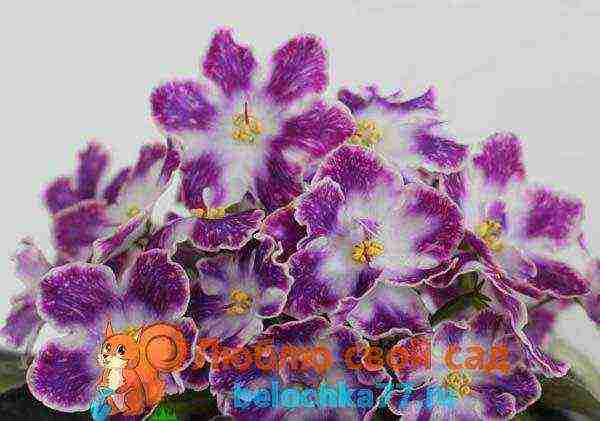 Raisin variety
Raisin variety
Lavender flowers with white dots on slightly ruffled petals. Blotches sometimes fill most of the petals. A wide white border runs along the edge. On the border of the border, a crimson strip is visible. The eye is white. The compact rosette consists of medium green, small leaves.
Peacock
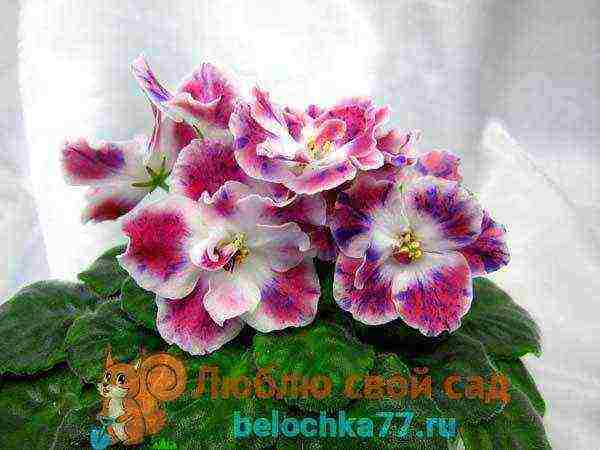 Peacock variety
Peacock variety
White large flowers are simple or semi-double. The petals are wavy with blue patterns and prints and coral. The rosette is flat, with green foliage. Abundant flowering occurs under artificial light.
Isadora
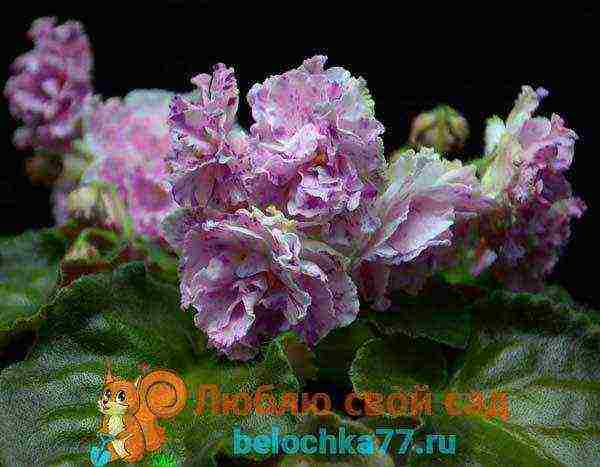 Isadora variety
Isadora variety
Snow-white flowers are very large, semi-double. Pink specks are scattered on them in abundance. The leaves are voluminous, dark green. Peduncles often bend under the weight of the buds.
Jan minuet
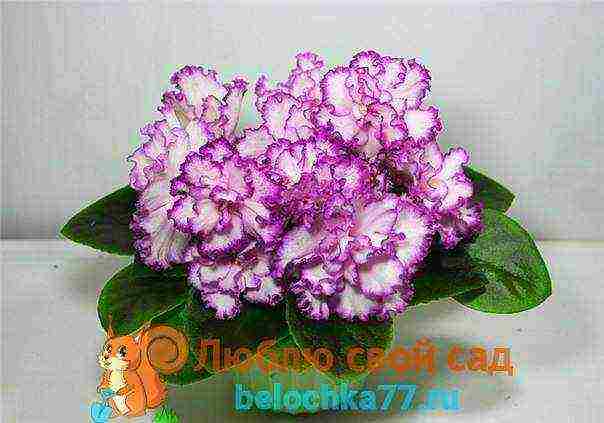 Jan minuet variety
Jan minuet variety
Large double flowers. They resemble stars. Their diameter is 7 centimeters. The color is pale pink, densely sprayed with a thicker shade. The border is crimson, corrugated, the width varies. The flowers show bright color transitions. The petals are wavy, large. The peduncle is strong, high. A round bunch of 3 flowers, similar to pompons, is formed on one peduncle. The foliage is slightly wavy, dark green, jagged edges. The socket is standard, small.
Ice rose
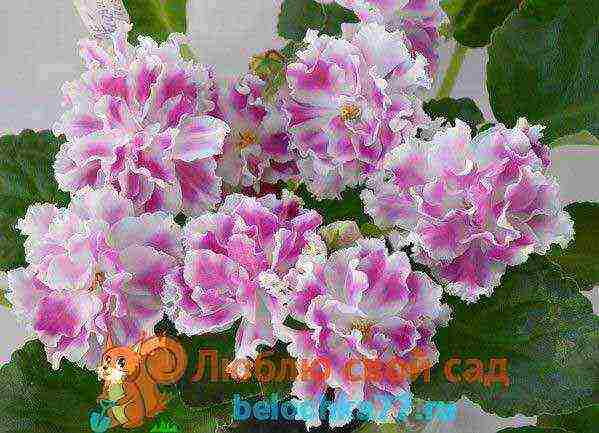 Ice rose variety
Ice rose variety
The variety attracts attention with its bright color of petals. The flowers are like noble roses. With each new bloom, the shade and structure of the colors changes. The inner part of the white petals eventually turns cherry or lilac, and the border of the petals turns light green. White petals have lilac or crimson-pink strokes. The edges are corrugated, light green or pale yellow in color. During the flowering period, 6-7 flowers are formed. The foliage is large, dark green. The edge is slightly wavy. The socket is large.
Rosemary
 Rosemary variety
Rosemary variety
It is a long-flowering, prolific variety in standard sizes. Flowers are large, double. The background of the petals is white. It can be seen along the edges and at the base of the petals. Above the background is a soft pink color and blue or purple splashes. The amount of splash on the petals may vary. Due to the abundance of petals, the violet looks like a pompom. The edge of the petals is curved, wavy. The rosette consists of toothed dark green leaves.
Mini
The rosette of these violets is small, no more than 20-25 centimeters in size. Today, about 2 thousand varieties of these miniature violets are known. They are less whimsical than other larger varieties.
Aquamarine
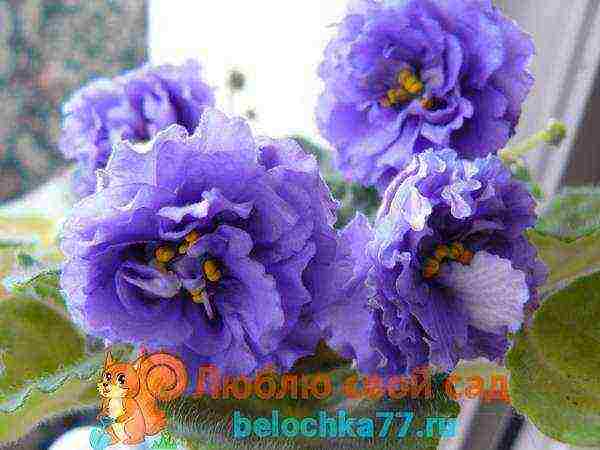 Aquamarine variety
Aquamarine variety
The variety is abundant and blooming for a long time. Flowers are rounded, double. The petals are white with blue streaks. Outside, the inflorescence is green. The leaves are green. The rosette is compact, 20-25 centimeters in diameter.
Oksana
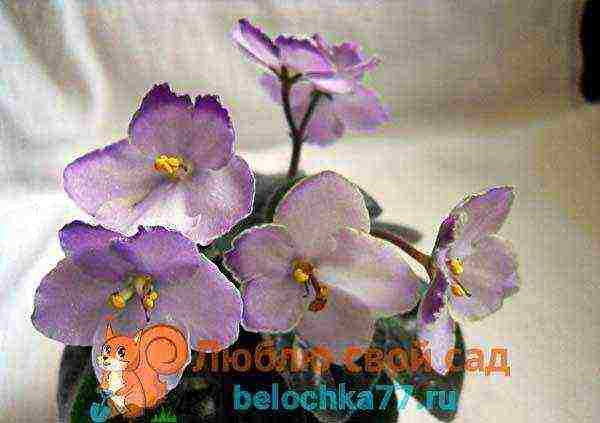 Variety Oksana
Variety Oksana
Variety of violets with semi-double large lavender flowers. The tips of the upper petals have a dark border. The leaves are dark green. The variety belongs to semi-mini violets.
Maria
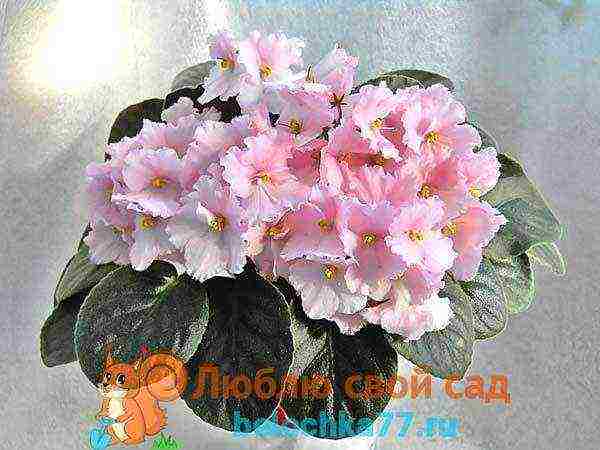 Variety Maria
Variety Maria
Variety with large double corollas with bright pink flowers. The flower resembles a miniature rose. A purple pattern covers each petal. The edges of the flowers look like ruffled ruffles. The rosette is deep green.
Retro
It is a sprawling, dense, fast-growing and unpretentious violet. The plant blooms often and for a long time.
Lilac flowers are bizarrely combined with light green and white. The petals are covered with an unusual vein-like pattern. Veins are clearly visible on the stem, of which there are up to 8 pieces.
Angelica
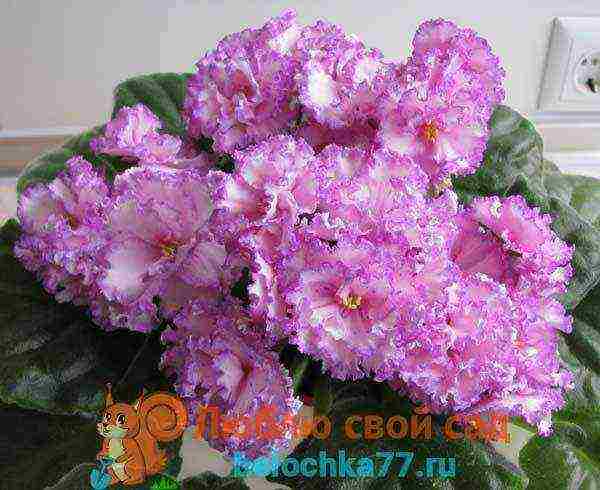 Angelica variety
Angelica variety
This mini-variety has large double light pink or dark cherry flowers with a coral core. The main highlight of the variety is the double edging of the petals. Leaves are deep green. Closer to the center of the flower is a strip of lilac splashes.Corrugated edge painted pure white.
Amadeus
 Amadeus variety
Amadeus variety
The variety has large red-crimson velvety double or semi-double flowers. Petals are oblong. They reach 5.5-6 centimeters in diameter. Corrugated edges. The border is thin, white. In the middle of the flower, a white tint is visible. Flowers are collected in compact inflorescences. As the flowers dissolve, the color of the petals becomes brighter. The leaf rosette is large, reaching 40 centimeters in diameter. Leaves are simple, large, light, almost olive, with long petioles.
Olesya
 Variety Olesya
Variety Olesya
Semi-double flowers are velvety, large. The color is deep, pink-burgundy. The socket is small. The leaves are medium-sized, dark green.
Frosty cherry
 Variety Frosty cherry
Variety Frosty cherry
The double flowers of this variety are large and very beautiful. The diameter of the flower reaches 4 centimeters. They do not become so immediately, but gradually. At the first flowering, the size of the flower is much smaller. In subsequent years, the size increases each time. The main color of the petals is cherry red. The border is wide and white. In the center of each petal is a large fuchsia spot.
Esmeralda
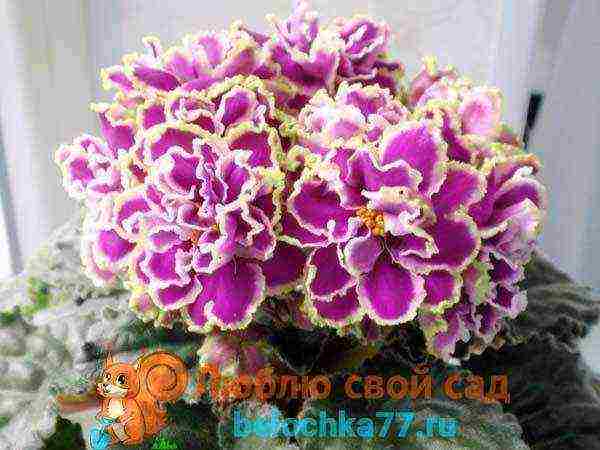 Esmeralda variety
Esmeralda variety
The variety has large velvety leaves. The flower is burgundy-crimson, double or semi-double. The edges are slightly darkened, the corrugated border is white-green. The border of the blossoming flower is green. At a cool temperature of the content, the color remains, and in a warm room it gradually turns white. The violet blooms with a luxurious hat.
Chateau Brion
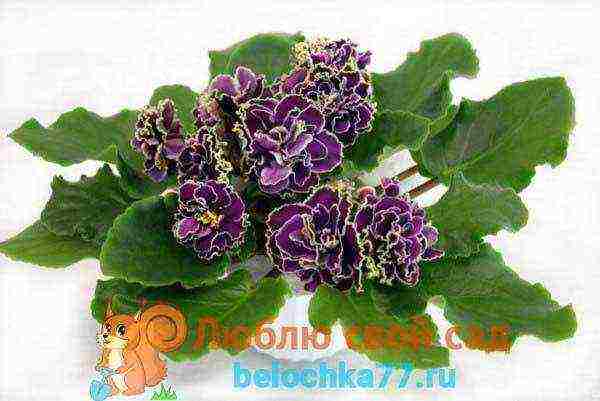 Chateau Brion variety
Chateau Brion variety
Peduncles are erect, powerful. Flowers are similar to pompons, large, double, wine shade. The edge of the petals is decorated with a wide, corrugated white border. The socket is standard. Leaves are slightly wavy, oblong-ovoid.
Violets - home care
Variegated
There are 3 types of variegation. The most beautiful view is with bordering variegation. In such plants, light areas are evenly distributed along the contour of the foliage.
The color of variegation can be white, cream, white-pink, brown, grayish-pink, less often yellow, dark pink. The intensity of the variegated color depends on the conditions of the plant and the air temperature. In a cool and well-lit room, the flower becomes brighter. With a lack of light, the leaves become greener, the variegation in some cases disappears completely (during flowering). By inheritance, the color is transmitted rather poorly.
With crown variegation, the center of the rosettes is colored golden, pink and white. This species is more stable, it is inherited.
Rows of green foliage alternate with colored foliage. During the flowering period, in most varieties, the center of the rosettes turns green.
Mosaic variegation is a more stable species. The foliage of such violets is partially or completely covered with an irregular intricate pattern, similar to the pattern on marble or a mosaic of cream, pink, strokes and spots. This type of violet is quite rare.
Another species is known, this is spontaneous variegation. These plants do not transmit variegation from parent varieties.
Summer twilight
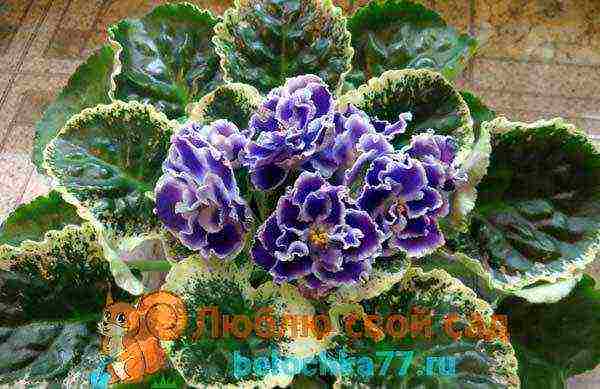 Variety Summer twilight
Variety Summer twilight
The flower is in the correct proportions. The flowering is quite abundant. Inflorescences are large, semi-double, contrasting. The background color of the petals is lilac-violet. The edges are trimmed with white ruffle. Leaves are variegated, slightly concave. The edges are slightly wavy. The rosette is flat, spherical.
Blue dragon
 Blue dragon variety
Blue dragon variety
The flowers are large, pale blue. The edge of the petal has a green-white border. The socket is powerful, flat. The leaves are dark green in color, with a crimson or purple tint on the inside. The variety is grown on a well-lit windowsill or loggia.
South night
 Variety South Night
Variety South Night
The cultivar has dark blue simple star-shaped flowers with bright crimson fantasy peas and thin white edging.The foliage is dark green with pink splashes. The socket is flat, standard sizes.
Chic poppy
 Variety Chic poppy
Variety Chic poppy
This is a variegated, large-sized flowers with a wavy fringed edge. Flowers reach 6 centimeters in diameter. The edges of the petals are hollow, similar to ruffles. The color of the petals is different, from light pink to orange-red tones. The leaves are pubescent, spatulate, decorative. Light greens from the center discolor and turn into white tones, making them variegated. Sometimes the leaves turn completely white.
How to grow violets at home
Ampelny
Ampel violets are intended for growing in pots, hanging pots. They decorate balconies, loggias, hanging flower beds. Plants have multiple growth points. A large number of new shoots are formed on the sides. Long stems are directed downward. They need good lighting. They bloom throughout the year. In winter, the plant needs additional lighting.
Lituanica
 Lituanica variety
Lituanica variety
Ampel variety with large double inflorescences. The petals are slightly elongated, similar in shape to small dahlias. The color of the flowers is pink-peach. The edge of the petal has a more intense color. Leaves are densely pubescent, dark green, pointed at the end. The stem is elongated. The rosette is high, well leafy, growing to an impressive size.
Grinya
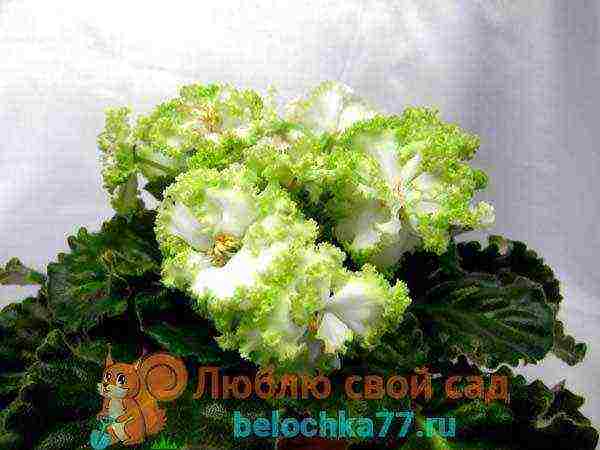 Grina variety
Grina variety
It is a slow growing hybrid. Flowers are large, semi- and densely double. At the bud stage, the flower is completely green. As it blooms, it grows larger and turns white. A wide green border remains along the edge of the corrugated petals. It disappears over time, after which the flower becomes snow-white. The rosette is thin, develops evenly. The leaves are wavy, rich green, hanging from the pot. Flowering lasts a long time.
Violets on the windowsill destroy privacy
White
White violets have large double flowers. The rosette is compact and consists of dark green leaves.
The bride's bouquet
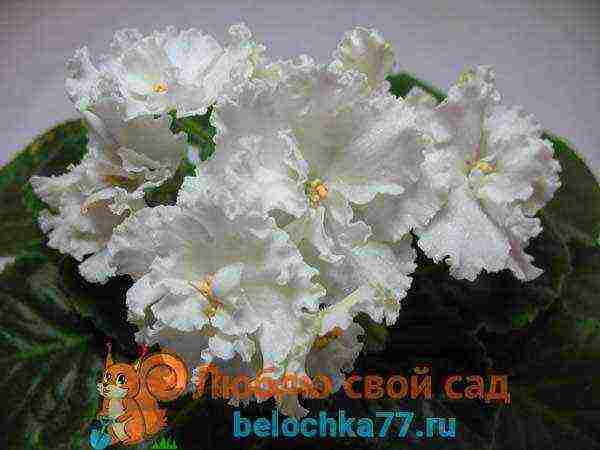 Variety Bridal Bouquet
Variety Bridal Bouquet
This richly blooming variety has large, star-shaped flowers in a pale white color. The edges are wavy. Flowers are like a bridal bouquet.
Whipped cream
 Whipped Cream Variety
Whipped Cream Variety
The flowers of this plant are white, large, double, lacy. The edge of the petal has a thin pink and crimson corrugated border. The socket is light, small. The foliage is slightly wavy.
Bridal bouquet
 Variety Wedding Bouquet
Variety Wedding Bouquet
The flowers are snow-white, very large, simple or semi-double. The center is bluish. Green corrugated border. Leaves are simple, light green. Standard size socket.
Pink
Georgia
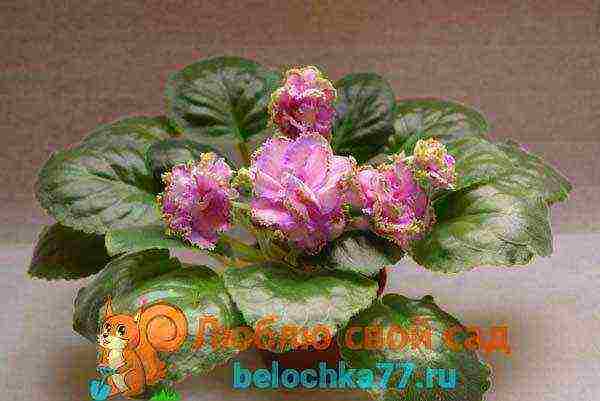 Georgia grade
Georgia grade
It is an abundantly flowering, very conspicuous variety. Flowers are bright pink, double, large. The edges are strewn with lilac specks. They are wavy, have a thin light green border. Flowers are formed on powerful, large peduncles. For abundant flowering, the variety requires proper keeping conditions.
Rose of Wind
 Wind rose variety
Wind rose variety
This delicate and very beautiful violet. The flowers are medium in size, about 4 centimeters in diameter, double, similar to lush garden roses. The petals are white-pink in color. Broken edges, corrugated light or dark pink. In some places, a green border is visible. The buds are located on a thin stem. The foliage is spreading, light green, forming a rosette. Several double flowers are formed on one peduncle.
Viola - growing from seeds
Purple
Don Juan
 Don Juan variety
Don Juan variety
It is a cultivar with large, purple-plum, plain or semi-double flowers. The border is wide, strongly corrugated, bronze-green in color. The foliage is dark green with a pink edging, slightly wavy.
Macho
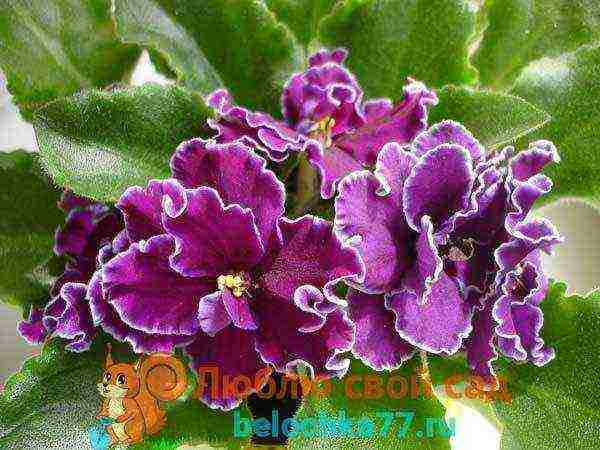 Macho variety
Macho variety
This is a semi-double chameleon variety. The flowers are claret-purple, almost black. The buds are densely arranged. A bright white border is visible along the edge of the petals. The flower turns purple in natural light, almost black, and burgundy when illuminated.Leaves are green, large, raised, ovoid. There are many peduncles, they develop and grow unevenly.
Duchess
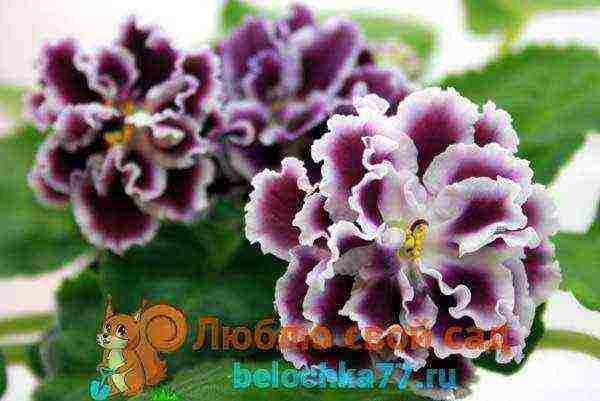 Variety Duchess
Variety Duchess
The variety pleases with excellent flowering. The flowers are huge, semi-double or double, the edges are wavy. Plum prints located in the center of the petals give decorativeness to the flowers. Powerful socket. The foliage is dark green, quilted, with noticeable veins.
Water
 Variety Water
Variety Water
Variety with large purple-blue flowers. At the edges, they have lighter fragments and abundant green ruffle. The dorsum of the corolla is lighter. Peduncles are low, strong, hold 4-6 spherical flowers. The leaf is green, quilted, wavy along the edges. The outlet is medium. Flowers open gradually, in cool weather they last for more than a month. The beauty of the variety is fully revealed in the second bloom.
Violet varieties: video
There are quite a few varieties and varieties of indoor violets, and each grower can choose them to his liking. Proper care allows you to preserve the peculiarity of a particular variety, preserving its uniqueness and beauty.
Chimera (or, in scientific terms, a periclinal chimera) can be recognized by the presence of a radial strip of a different color on each petal of a flower. Cells with different genetic information are located in such a plant in a strictly defined way. This mutation is rare and very attractive. Leaf chimeras are even less common: in this case, the stripes are located on the leaves of the plant.
Violet chimera, photo
No matter what efforts the breeders make, it has not yet been possible to purposefully obtain a chimera from a seedling or in a laboratory. It happens that a seedling blooms with a chimera, or a child of an ordinary variety opens striped flowers. The appearance of a chimera is a real gift from nature.
Of course, one would like to preserve beautiful chimeric mutations, and this requires some effort. Chimera cannot be propagated by leaf cuttings: children will repeat chimeric signs with a probability of less than 1%. Therefore, such plants are propagated by side stepchildren or peduncles. It is clear that in this case it is impossible to obtain a large amount of planting material and the value of the variety increases.
I note that chimeras, like other Saintpaulias, alas, do not have 100% repeatability. The reason is the same: violets mutate easily, so some plants can bloom with sports. For example, more than two hundred varieties of chimeras have visited my collection, and about 15% of the acquired stepchildren have bloomed incorrectly.
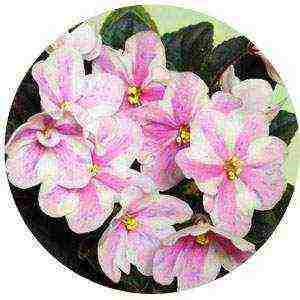 Both with the breeding of new varieties by pollination, and with chimeras, it is necessary to check the repeatability of varietal traits in at least three generations. It's great if the plant bloomed with a chimera on all peduncles, which means that you can cut off the crown, grow side stepsons and check them for the repeatability of varietal traits. These stepchildren are considered second generation plants. Of these, the most correctly flowering specimen is chosen and the procedure is repeated: the top of the head is cut off, the stepsons are grown.
Both with the breeding of new varieties by pollination, and with chimeras, it is necessary to check the repeatability of varietal traits in at least three generations. It's great if the plant bloomed with a chimera on all peduncles, which means that you can cut off the crown, grow side stepsons and check them for the repeatability of varietal traits. These stepchildren are considered second generation plants. Of these, the most correctly flowering specimen is chosen and the procedure is repeated: the top of the head is cut off, the stepsons are grown.
In addition, you need to make sure that the resulting plant is a chimera, and outside the laboratory you can check this by planting a leaf cutting the chimera children will not repeat the maternal color. As a result, testing a new variety can be time-consuming.
Sometimes the chimera is not very pronounced, but the color is interesting. In this case, the breeder continues to work, choosing the best specimens until he gets a clear color. This work is called "cleaning" and "fixing" varietal traits.
It happens that only part of the peduncles gives striped flowers. Then the following options are possible: the side from which the "striped" peduncle was obtained is marked on the plant, and the stepchildren are checked from this part of the trunk.
A more complex, but also more reliable option is to fix the chimera with a peduncle.To root a peduncle (we choose with the correct color of flowers) is more difficult than a leaf cutting, the requirements for the composition of the soil, temperature and light conditions are higher, but with certain skills this is a feasible task.
Peduncles with well-developed stipules take root better. A bud wakes up in the axil of the peduncle, and a stepson grows out of it. If there is only one striped peduncle on the plant and its stipules are small, it is better to grow a stepson without removing the peduncle from the plant. For this, a hormonal (cytokinin) paste is used. A needle, the tip of which is smeared with a paste, scratches the sinus of the peduncle. After about two weeks, a kidney wakes up at the site of the scratch and a stepson develops.
Separately, it should be said about leaf chimeras. The only way for them to reproduce is by rooting stepchildren from the trunk. At the same time, quite a lot of monochromatic green plants are obtained. This is why leaf chimera is even more rare than flower chimera. But the coloring of the stepson is visible immediately.
No matter how fixing is done, the repeatability of features must be checked for at least three generations. Only after this can the chimera get its name and become an independent variety.
Features of agricultural technology
I often heard the question whether the rules for growing chimeras and other violets are different. All my Saintpaulias grow in the same conditions, but for those who want to replenish their collection with chimeras, I advise you to pay attention to the following points.
For any violets, stresses (a critical increase or decrease in temperature, dryness or flooding, excess fertilizers, acidification or salinization of the soil) are undesirable. But if the usual variety can be preserved by rooting the leaf, then this option will not work with the chimera. Therefore, favorable growing conditions and their constancy are especially important for her.
How do I save the variety
I usually propagate my chimeras with peduncles for this there are two reasons: firstly, the repeatability of the stepsons obtained from the peduncle is higher. Secondly, if the top of the plant is cut off, then against the background of the stress received, it turns on internal defense mechanisms, minor genetic failures accumulate. Often such plants tend to return to a more stable form, and the violet loses its chimeric features, tissue with more stable genetics grows, the stripes are smeared or completely disappear, sometimes this process is irreversible.
Reproduction of chimeras with peduncles and sepals (video)
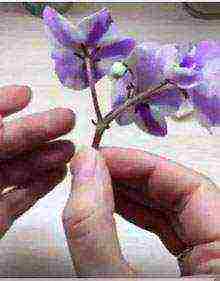
Unfortunately, it is impossible to completely protect plants from stress in an apartment. For example, I do not have an air conditioner, and even if I maintain all other agricultural techniques at the proper level, I cannot withstand the high summer temperatures.
In order not to lose the variety, I regularly root the correct peduncles and approximately every 2 years I replace the mother plant of my stepsons.
And in conclusion, I want to say that the striped bouquets of my favorite chimeras have never given reason to doubt that keeping these Saintpaulias in a home collection is worth the effort. And the joy of breeding a new chimera can be reconciled with the large amount of time and space required to check and consolidate varietal traits.
Marina Filippova, Minsk
see also
|
Violet Everyone likes Saintpaulia. And not because it never bothers you or takes up little space. Have you often seen her without flowers? No? Well, here's your answer! |
|
|
Caring for a sick violet at home My humble experience, I hope, will be useful to novice lovers of Saintpaulias. It so happened that more than once it was necessary to nurse sick violets. Now I can give some true advice on saving even the most hopeless plants ... |
Did you know that such a wonderful flower like a violet can be not only blue or purple shades, but all kinds of colors of the rainbow?
And in terms of beauty, these fragile flowers will not yield to even the most crowned representatives of the plant world.To talk about all the varieties of violets, you will need to write a whole book, but we worked hard and chose the most charming types of violets for you. This article is about the most beautiful violets in the world.
My love is a beautiful violet
Blooming on the banks of the river ...
Frosty Cherry

Luxurious double cherry-scarlet flowers with white fringes will not only decorate any windowsill, but will also become a real decoration of your flower bed or garden.
An interesting fact is that the flowers over time acquire a more saturated dark color, but from the lack of light, on the contrary, the flowers brighten. This thermophilic variety does not tolerate cold, but it also does not tolerate heat, and humidity is not desirable when growing Frosty cherries. If you adhere to all the rules of caring for your favorite flower, it will give you a violent and long flowering.
Ice rose

Don't believe such a prickly name, in fact it is one of the most beautiful varieties of violets. This wonderful flower combines three of the most unpredictable shades: light green, white and cherry. A beautiful ruffled fringe adorns the lush flower, making it even more luxurious.
Chic poppy
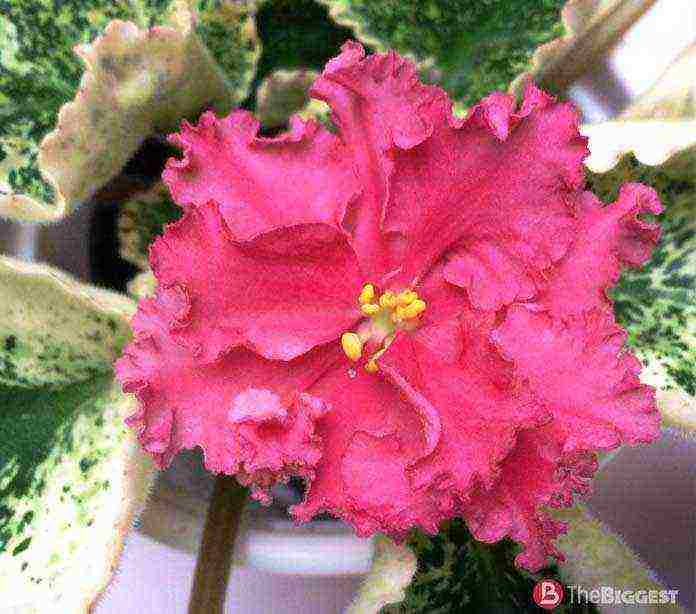
This truly gorgeous flower is distinguished not only by a pleasant aroma, but also by large double flowers of a light crimson color. The flower itself resembles a light dress with ruffles fluttering in the wind.
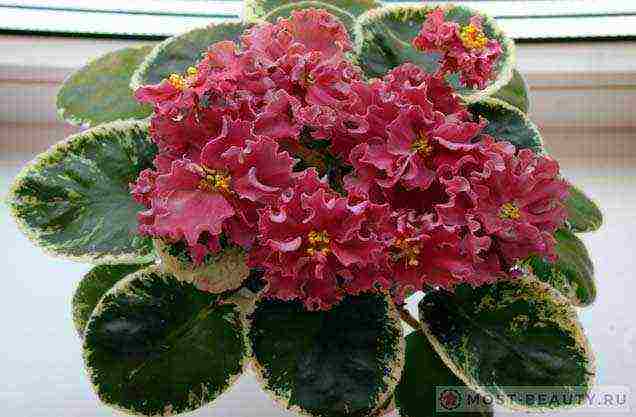
It is impossible not to mention the peculiar color of the leaves, where the light shade gradually turns into a dark emerald color. Be sure to add the Chic Poppy violet to your collection and it will become a diamond in your garden.
Isadora
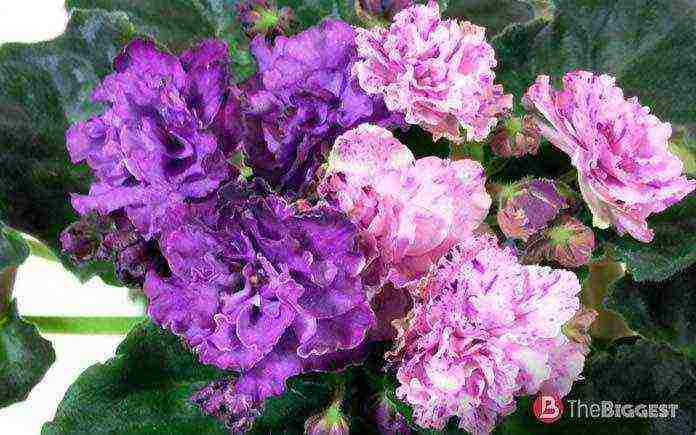
This is the most amazing variety of violets in flower color. Very beautiful semi-velvet lush flowers of a pink hue with lilac spots and ruffles-rims will not leave even not very avid florists indifferent.
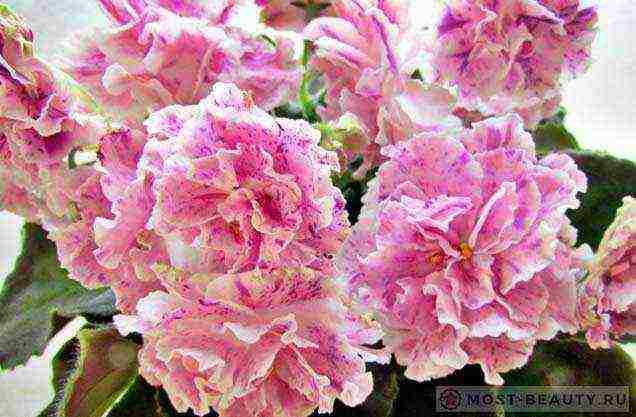
The flowers themselves resemble mini-peonies, and the leaves of a noble dark green color give Isadora even more charm and grace.
Lituanica
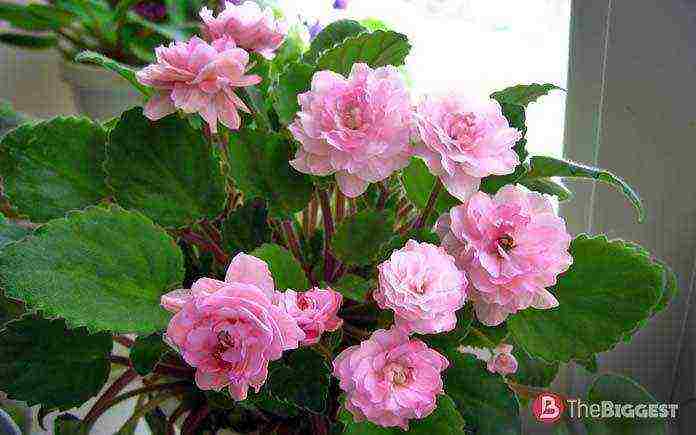
But Lituanica is the most unlikely violet variety bred by breeders. Lituanica inflorescences most likely resemble the flowers of a tea rose, rose hips or dahlias. But, despite this dissimilarity with their direct relative, the flowers of Lituanica do not cease to be such light and enchantingly beautiful representatives of Saintpaulia, but among the people of Violets.
Rosemary

One of the most exquisite representatives of the violet genus, without a doubt, the beautiful Rosemary.
Its delicate, semi-velvet pink petals are decorated with purple patterns and wavy edges, reminiscent of coral reefs. The buds themselves are very lush and bright, for one flowering a violet can throw out 5-6 flowers, when all the buds are blooming, the Rosemary violet simply charms the look with its beauty and splendor.

This variety loves moderate watering, so do not overdo it with watering, but for good flowering, these flowers should be placed in bright rooms.
The bride's bouquet

One of the most delicate varieties of violets, it is very much appreciated by collectors precisely for its snow-white flowers, for violets it is a rarity. This variety was called “Bridal Bouquet” for a reason, the magnificent snow-white flowers of this violet would serve as a wonderful decoration for any bride. The inflorescences of this variety resemble stars, bloom magnificently and have a light pleasant aroma. Leaves as well as flowers have a uniform dark green color.
Amadeus
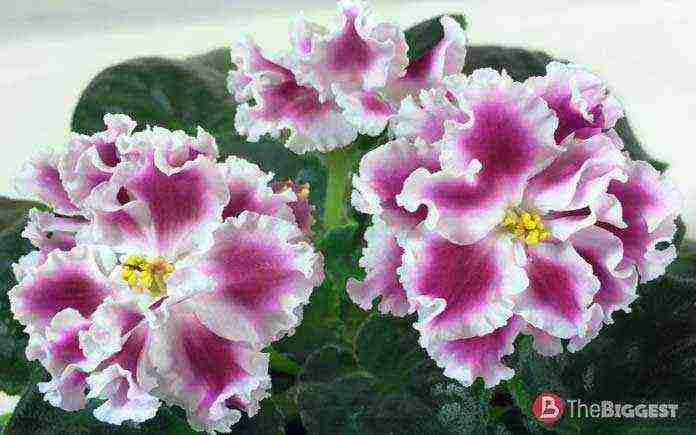
Excellent Amadeus will decorate any collection of an amateur florist. Terry flowers with a white center, crimson petals and a white border will not leave anyone indifferent.
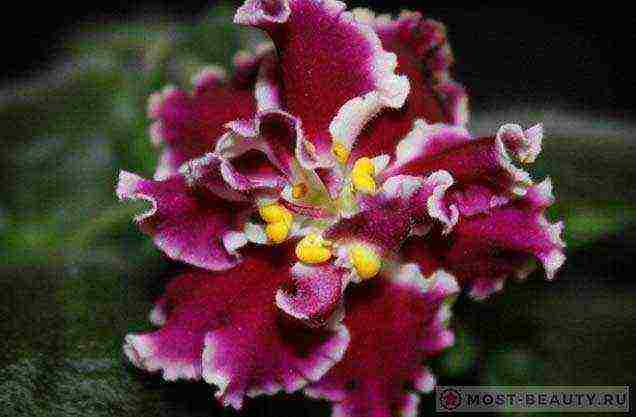
The leaves of Amadeus are medium green, so to speak, the variety is not whimsical and does not require much attention from you, but if you treat the plant with love and care, you will be rewarded with the lush flowering of the enchanting Amadeus.
Magenta
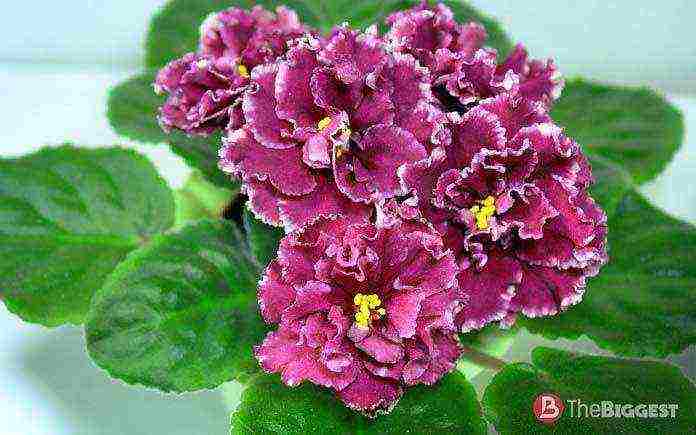
Beauty Magenta is the result of the painstaking work of the talented breeder E. Lebetskaya.
The result, I tell you, is simply amazing.Dark burgundy petals framed by dark green leaves look very chic. The edges of the inflorescences are framed by a barely noticeable white border.
Birth of love

Large, lush fringed flowers of the "Birth of Love" variety look like a fluffy cloud, the delicate milky pink color of the flowers gives tenderness and lightness to this beautiful plant.
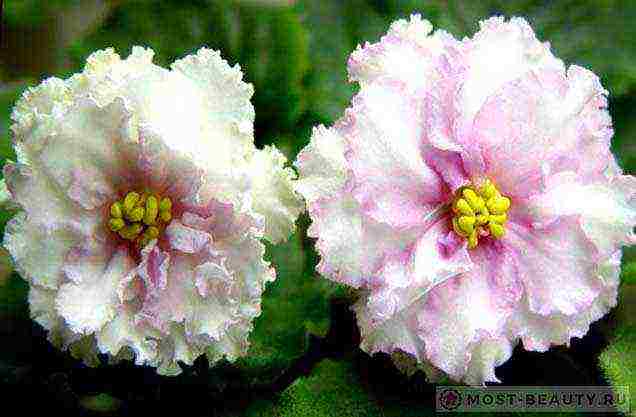
A violet of this species loves warm sunny days and not very abundant watering. The violet does not bloom for a long time, about two weeks, and pleases the eye, both the owners and their guests.
Gray ocean
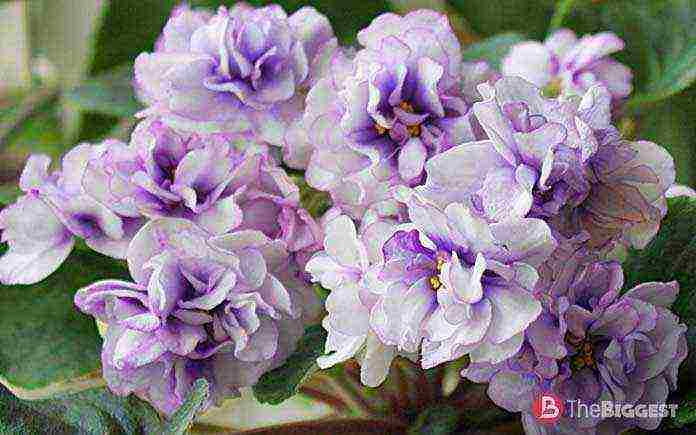
This variety is famous, first of all, for its changeable character. Breeders often call him a chameleon among violets. And the thing is that with each flowering, the amount of white on the petals decreases, giving way to blue, and over time, the Gray Ocean smoothly turns into a variety called "Black Pearl".
Chimera
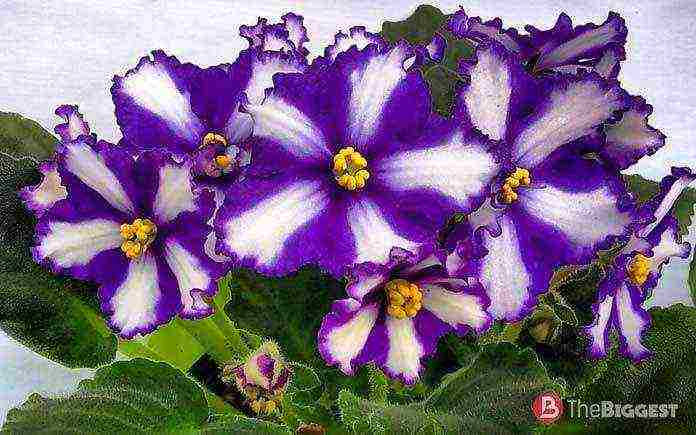
A feature of this variety is the fact that the Chimera violet is a mutant plant, this variety has not been bred by breeders, it turned out by chance due to a mutation of two types of violets. Flowers of this variety are also special. The color of the violet can vary from pale blue to dark crimson. Each violet petal has a white or light line down the center. This is a mandatory distinctive mark of the Chimera.
Paul Bunyan

One of the most popular varieties of violets, not only among breeders, but also among ordinary indoor plant lovers. This variety has a lot of inflorescences of light raspberry-gray shades. Paul Bunyan blooms magnificently and for a long time. The leaves of this enchanting flower are terry, dark green in color. The only disadvantage of this variety is that the flower grows very quickly and requires frequent transplantation.
Darling
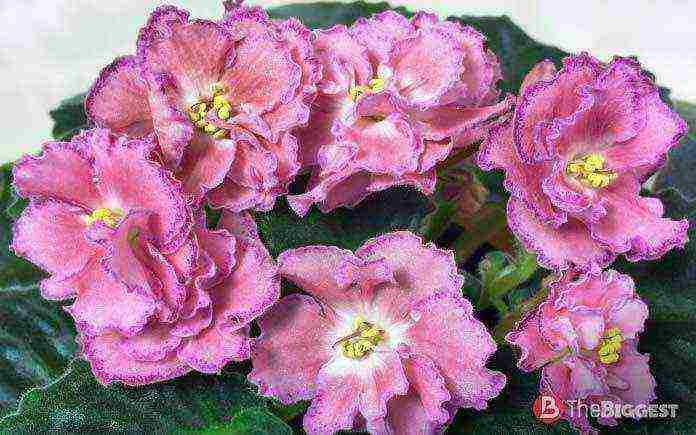
This violet variety will delight you with its flowering almost all year round. Its flowers are very delicate, almost airy, more often of a light pink color, but there is also a milky peach color of flowers. The flowers themselves are not very large, but there are many of them on the bush. Darling is not at all whimsical in leaving, loves warmth and moderate moisture. If you want flowers with whiter petals, then put the violet in a cooler place.
The land of crimson clouds

This violet has a very intricate name, and it itself is very unusual. Beautiful warm crimson flowers with a yellow core adorn the dark green leaves with pink edging around the edge. This exotic variety will become an irreplaceable decoration for your windowsill.
Conclusion
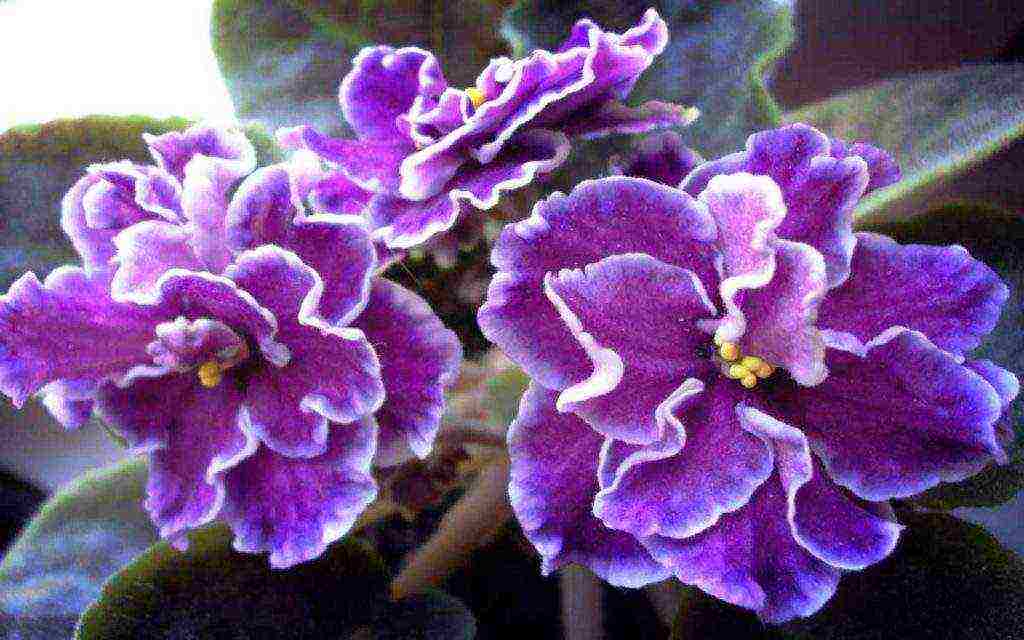
There are more than 500 species of violets around the world, yes, yes, breeders have tried. From all this beauty, we tried to choose the most unusual and beautiful varieties. If your favorite variety is not included in our rating, do not be discouraged, but write about it in the comments. Thank you for your attention.
The author of the article is Lydia Rudya.
